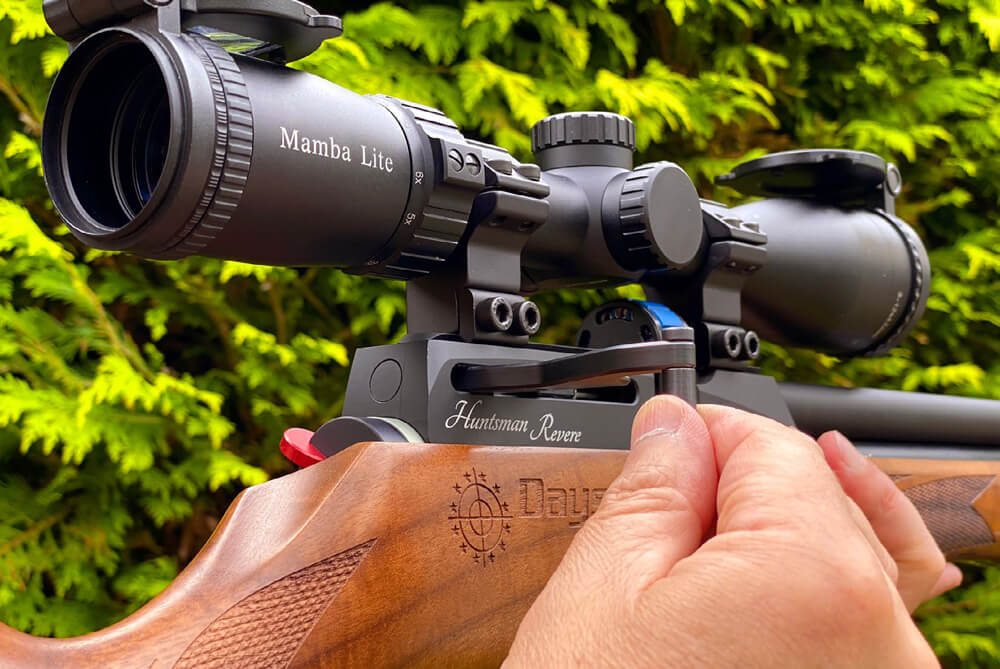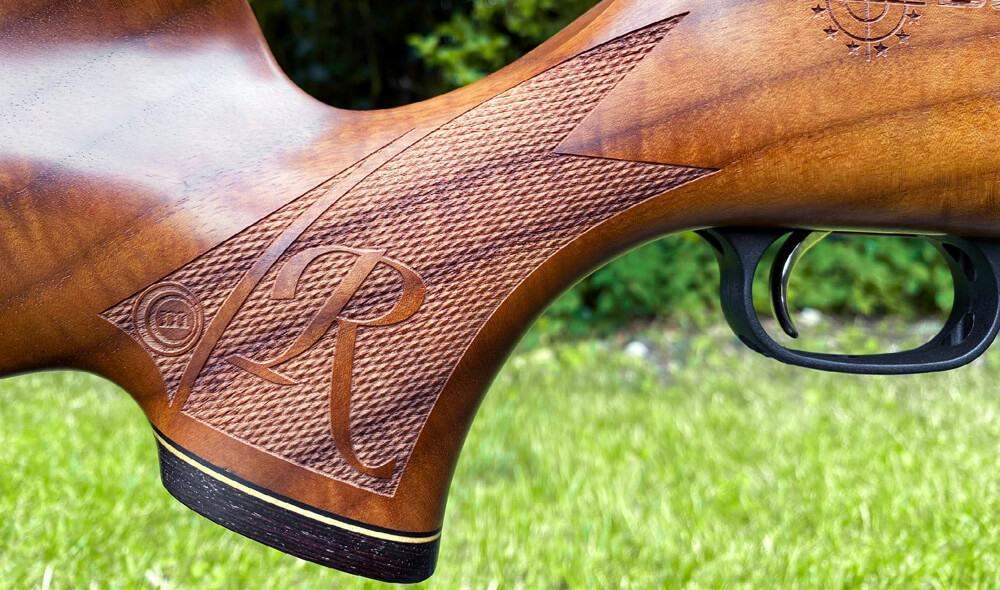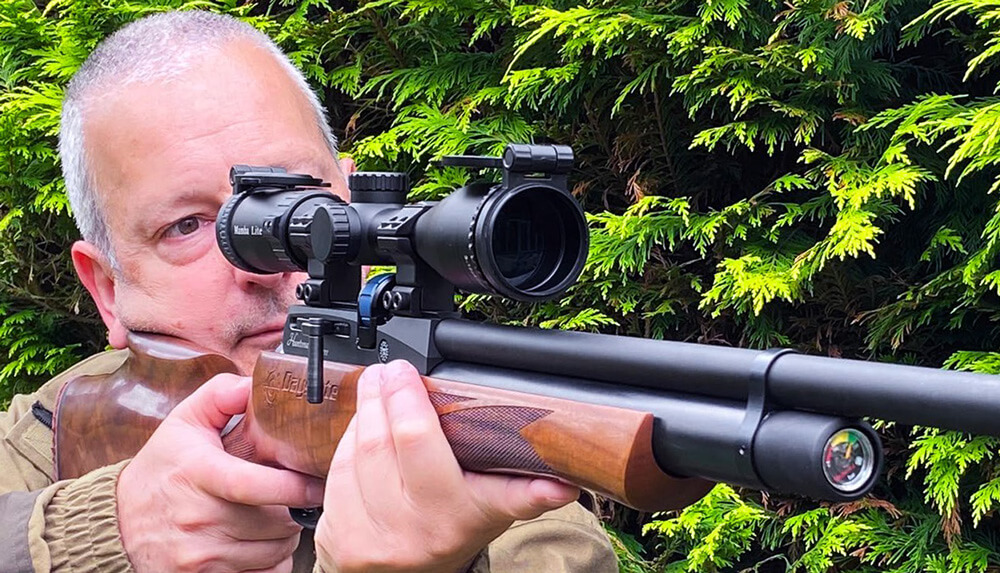What’s Changed with Daystate’s new sporter?
Mike Morton tests the Daystate Huntsman Revere and finds a rifle that stays true to its traditional roots while adding in some modern twists
Daystate’s bestselling rifle is the Huntsman, and while it’s been subjected to numerous redesigns and improvements, it can still trace its lineage back to when the company started out more than 40 years ago. But it’s those redesigns and improvements that have maintained the Huntsman’s presence over the decades, with the latest incarnation being the Revere.
Part of the Huntsman’s appeal lies in its traditional looks, with the bulk of the air cylinder being seated deeper in the stock, making it look more like a rimfire rather than an airgun, and with the Revere, Daystate has managed to retain that slimline sporter appeal, while making some exciting changes. Traditionalists needn’t worry about these alterations though, because the Revere will sit alongside the bolt-action Regal rather than replace it. Instead of a turn-bolt, the Revere offers a sidelever cocking action paired with a new gate-loading magazine that has an increased shot capacity – 13 pellets in .177, 11 in .22 and 10 in .25 calibre. It also combines the latest version of the Huntsman’s hammer and valve system with the Huma regulator that first appeared on the HR Huntsman Regal. Why the need for change? Well, sidelever actions are generally faster to operate and require less cocking effort on behalf of the shooter, making them especially useful for higher-powered rifles, and in FAC format the Revere offers up to 18 foot pounds of muzzle energy in .177 calibre, 30 in .22 and 40 foot pounds in .25.

STOCK The Revere is available as either a dedicated right- or left-handed rifle, with the stock, the sidelever cocking action and the way the magazine is inserted all switching sides depending on what the shooter’s preference is. The stock will be familiar to any existing Huntsman owners, as it’s the same one that appears on the Regal. This is a beautiful oiled walnut stock made by Minelli, and it manages to be both elegant and practical, thanks to the panels of chequering that adorn the pistol grip and the long, slim forend. Four separate panels have been used on the forend to create a flowing design that covers the belly of the stock, providing additional grip for the leading hand. The curved blade lets you eke the best performance out of the trigger unit, which broke cleanly on the test rifle with a trigger-pull of 1lb 2oz The Revere comes in either a dedicated right- or left-handed stock with a raised comb and a rollover cheekpiece At the butt end, there’s a ventilated brick red rubber shoulder pad with a black spacer, and in keeping with the Huntsman’s traditional design, the pad is not adjustable for height or cast. Moving forward, there’s a pronounced cheekpiece with a raised rollover comb, which makes it feel more comfortable against the face. The pistol grip has quite a shallow rake, which fits the traditional design brief of the Huntsman, although my preference is for a steeper rake. In general, a shallow rake will let you get on aim more quickly, while a steeper one is slower, but can be more comfortable and offers more control. What I do appreciate, however, is the provision of a thumb shelf which lets the shooter adopt a thumb-up grip. Weighing 2.8kg unscoped, and with the centre of balance being just forward of the polymer trigger guard, the Revere is certainly a handy little sporter, being very quick to shoulder from a variety of stances, such as standing and kneeling, while the long forend makes it suitable for shooting off sticks.

FIT, FINISH AND FUNCTION
The action block, shrouded barrel and air cylinder have been given a black finish that’s almost matt in appearance, which will be less reflective in the field. Hunters will also appreciate the red anodised safety catch at the rear of the action block, which should be turned clockwise for ‘fire’ and is quiet in operation. The barrel is shrouded, but the muzzle crack is still a little snappy, so I fitted a 0Db moderator during my test period, which extends the overall length of the Revere, but didn’t appear to harm the way it handled. Contrary to many other Daystate rifles which use a Foster connector, the Huntsman uses a fill probe, the port for which is kept clean behind a twist-to-open collar that’s located just in front of the barrel band. Air is delivered via the Huma regulator, and it’s safe to fill this rifle all the way to its standard working pressure of 250 bar, which delivered around 140 shots in the .177 calibre sub-12 foot pound rifle that I had on test. The biggest difference between the Revere and the Regal is of course that sidelever action, which features a biathlon-style handle, making the lever easy to locate and almost effortless to cycle. I initially adopted a pinch-grip on the lever to cock the action and index the magazine, but actually found it quicker just to use one finger. Daystate has made an excellent job of this system and diehard bolt-action fans should really give this a go – they may be more than pleasantly surprised. The next big change is Daystate’s new-style drum magazine, which as well as providing a greater shot capacity is quite different to what we’ve seen before. While at a glance it looks similar to Daystate’s older magazines, the new mag is larger, and this may well affect your choice of scope and mounts as it sits higher in the breech than Daystate’s previous designs.
CONTRARY TO MANY OTHER DAYSTATE RIFLES, THE HUNTSMAN USES A FILL PROBE
As well as needing high mounts to fit the dovetail rail, you’ll also need to keep an eye on the size and shape of the saddle on the scope tube to make sure it doesn’t come into contact with the magazine. The test rifle came already equipped with a little MTC Mamba Lite 3-12×42, and this was a good choice as the Revere is a dainty rifle and a larger optic would probably have affected its fasthandling capabilities. Turning our attention back to the magazine, the new design features a hinged faceplate that must be opened to reveal the inner rotor. To load the magazine, drop a pellet into the bottom chamber – the one that aligns with the bore – then turn the rotor clockwise, dropping pellets into the remaining chambers as you go. The rotor is under some mild spring tension as you turn it, but a small post has been machined into the backplate which makes contact with the last pellet loaded, and this stops the rotor from unwinding should you let go of it by mistake. With all the chambers filled, you can go ahead and close the faceplate, which is held firmly in place by a small, but very powerful magnet. Depending on the diameter of the specific pellets you’re shooting, they may be a loose fit in the rotor. They won’t fall out with the faceplate closed, but for a belt and braces approach you can thumb them deeper into the rotor so they’re held more securely. With the faceplate swung down and out of the way for loading, this system is much faster and easier than with the previous magazine designs. Anyone not needing the fast-fire capability of the high-capacity magazine can fit the optional single-shot tray. This is Daystate’s more recent style, being a polymer body with a deep loading channel that’s secured by two locator pins and magnets.

READY FOR THE RANGE
The test rifle was configured for a right-handed shooter, and this means the magazine must be inserted from the right, as it uses a small magnet and locator pin to correctly seat the magazine. The magnet and pin are fixed and can’t be swapped round, but it is possible to order a lefthanded Revere with the mag entering from the left, or order a left-handed magazine as a spare. While older magazines can’t be used in the new action, the new magazine is compatible with other rifles such as the Wolverine, Pulsar, and the Huntsman Regal.
THE MAGAZINE WORKED WELL AND THE SIDELEVER WAS EXCEPTIONALLY SMOOTH

The faceplate has a series of cutouts through which you can look to give you an idea of how many pellets you have remaining, but in practice I found it easier just to rely on touch – when you close the sidelever you can feel a slight resistance as the pellet is probed forwards into the bore. Do keep an eye on your ammo count though, because it is possible to double-load the Revere if you’re not paying attention. The trigger is very good for a mechanical rifle, with the wide, curved blade delivering plenty of feedback and control. First-stage travel came to a definite stop, while the second stage broke cleanly with 1lb 2oz of triggerpull. That’s a tad light for the field, and I’d adjust it a little heavier if I was taking it hunting, but since it wasn’t necessary, I left it as it came during the test period.
Chrono testing was impressive. Using Rangemaster Sovereign pellets, which weigh 8.4 grains, the Revere delivered a 10-shot string with an average muzzle velocity of 763.3 feet per second, a muzzle energy of 10.87 foot pounds and a 4.6 feet per second velocity spread. By the time I’d taken my first 40 shots I’d managed to lead the barrel and zero the Revere at my usual distance of 30 yards, and had also managed to put 13 pellets – a whole magazine’s worth – into a one-hole group measuring 6.4mm. I’d be more than happy to achieve that with a rifle that’s been well run in after hundreds of shots, let alone a brand new one. I’ll typically shoot two or more different pellets through a test rifle to see if group size can be shrunk further, but was pleased enough with the Sovereigns, so stuck with those. Back at 40 yards, and remember this was with that little 3-12x scope up top, the Revere was happy to churn out five-shot groups measuring around 11mm centre-to-centre. Needless to say, I was impressed by this gun. Coming in at £1,068.57 for the sub-12 foot pound rifle I had on test, it’s certainly not cheap, but it does ooze quality. I didn’t manage to get perfect head and eye alignment due to the height of the scope and the non-adjustable nature of the stock, but the magazine worked well and the sidelever was exceptionally smooth. While I will always enjoy shooting guns with a turn-bolt action, I’ve become something of a sidelever believer over the past few years, and the Revere is a perfect example of what makes this system so good. I had the chance to shoot the Revere alongside a Regal for a direct comparison, and even the owner of the Regal admitted the Revere was smoother and faster to operate. But Daystate has cleverly covered both bases with the Huntsman. Sporting rifle purists can carry on enjoying this rifle in old school bolt-action Regal format, while anyone appreciating the speed and slickness of the new action can choose the Revere.